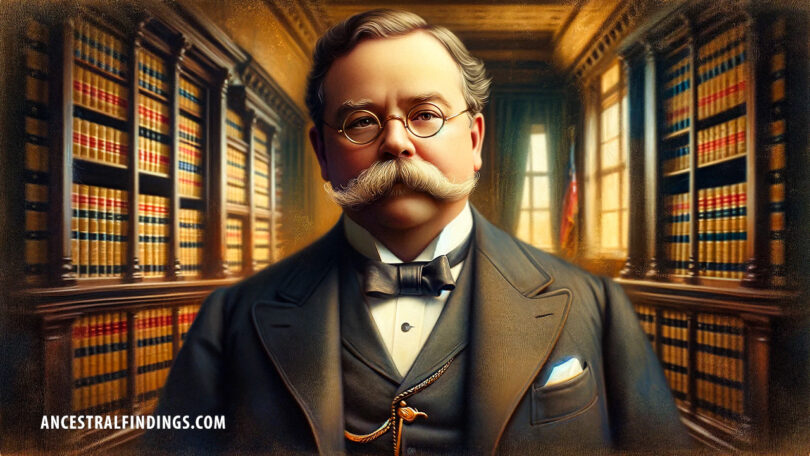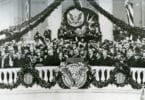William Howard Taft was born in Cincinnati, Ohio, on September 15, 1857, to Alphonso Taft and Louise Torrey Taft. His father, Alphonso Taft, was a prominent lawyer, politician, and public servant who served as Secretary of War and Attorney General under President Ulysses S. Grant. Alphonso was born in Townshend, Vermont, into a family of English ancestry. The Taft family’s roots in America date back to the 1600s, when Robert Taft emigrated from England to Massachusetts.
William’s mother, Louise Maria Torrey, came from a family with deep New England roots. Her ancestry is traced back to early settlers of Massachusetts, including prominent Puritan figures. Louise was born in Massachusetts and was the daughter of Samuel Davenport Torrey and Susan Holman Waters. The Torreys were known for their religious devotion, and Louise’s father was a successful businessman.
The Taft family’s English heritage and longstanding presence in New England significantly influenced William Howard Taft’s upbringing, instilling a strong sense of duty, public service, and legal tradition in him.
Early Legal Career and Marriage
After being admitted to the bar, Taft’s legal career flourished in his hometown. His time as a lawyer and later as a judge on the Superior Court of Cincinnati gained him recognition for his fairness and dedication to the rule of law. In 1886, Taft married Helen Herron, affectionately known as Nellie. A politically astute woman, Nellie played a crucial role in Taft’s career, pushing him to aim higher and supporting his ambitions every step of the way. The couple raised three children—Robert, Helen, and Charles—in an environment filled with political discourse and public service.
Rise to National Prominence
Taft’s legal career continued to ascend, and in 1890, President Benjamin Harrison appointed him as Solicitor General of the United States. This role allowed Taft to argue significant cases before the Supreme Court, cementing his reputation as a sharp legal mind. Two years later, he was appointed to the United States Court of Appeals for the Sixth Circuit, where his judicial decisions highlighted his balanced and fair-minded approach to complex legal issues.
Governor-General of the Philippines
In 1900, President William McKinley tapped Taft for a new challenge, appointing him as the first civilian Governor-General of the Philippines. While managing this new U.S. territory, Taft was responsible for building a stable government, improving infrastructure, and promoting education. His administration in the Philippines earned him a reputation as a capable and empathetic leader who worked to foster goodwill among the Filipino people.
Secretary of War
Taft’s success in the Philippines didn’t go unnoticed. Impressed by Taft’s administrative abilities, President Theodore Roosevelt appointed him Secretary of War in 1904. While overseeing the construction of the Panama Canal, Taft also played a vital role in managing military affairs and expanding U.S. influence abroad. Roosevelt, seeing in Taft a natural successor, encouraged him to pursue the presidency.
Path to the Presidency
1908, with Roosevelt’s endorsement, Taft secured the Republican nomination for president. His campaign was built on continuing Roosevelt’s progressive legacy, and he won the election, defeating Democrat William Jennings Bryan. Taft was inaugurated as the 27th President of the United States in 1909, but his presidency would soon reveal the differences in style between him and Roosevelt.
Presidency (1909-1913)
Antitrust and Economic Policies
Though often overshadowed by his predecessor, Taft was a strong proponent of antitrust legislation. He pursued over 70 antitrust suits during his presidency, including cases against corporate giants like Standard Oil and the American Tobacco Company. His administration also passed the Mann-Elkins Act, strengthening the Interstate Commerce Commission’s authority to regulate industries like telecommunications and meaningfully expanding federal oversight.
Judicial Reform and Administration
Taft’s legal background heavily influenced his presidency. He sought to improve the efficiency of the judiciary, advocating for reforms that would streamline the legal process. His support for the creation of the Commerce Court, though controversial, stemmed from his belief in a well-regulated legal system capable of handling economic and commercial disputes efficiently.
Tariff Reform and the Payne-Aldrich Tariff
One of the more divisive moments in Taft’s presidency was his handling of tariff reform. The Payne-Aldrich Tariff Act of 1909, intended to reduce tariffs, ended up preserving high rates on certain goods, frustrating progressives who had hoped for more significant changes. This issue would drive a wedge between Taft and the progressive wing of the Republican Party, souring his relationship with Roosevelt.
Foreign Policy and Dollar Diplomacy
Taft’s foreign policy, often called “Dollar Diplomacy,” aimed to extend American influence through economic investments abroad, particularly in Latin America and East Asia. Taft believed the U.S. could foster stability and development by encouraging American businesses to invest in foreign markets while securing its own economic interests. However, critics argued that this approach prioritized business over diplomacy, and its long-term success was limited.
Personal Traits and Character
Despite his imposing stature, Taft was known for his kind, approachable demeanor. Friends and colleagues often described him as a gentle giant with a sharp wit. He was also the subject of public fascination due to his weight, with exaggerated stories—like his allegedly getting stuck in the White House bathtub—becoming part of his public persona. While the bathtub story is most likely apocryphal, the White House did install an oversized tub large enough to fit four men, a humorous nod to Taft’s size.
Taft was also a great baseball lover, often attending games during his presidency. In fact, the tradition of the seventh-inning stretch is said to have gained national attention when Taft, attending a game, stood to stretch his legs. The entire crowd followed suit, thus sparking a tradition still beloved today.
Post-Presidency and Chief Justice of the United States
After losing his re-election bid in 1912 to Woodrow Wilson, Taft returned to academia, teaching constitutional law at Yale University. But his passion for the law had not faded. In 1921, President Warren G. Harding fulfilled Taft’s lifelong dream by appointing him Chief Justice of the United States, which allowed him to leave an indelible mark on the judicial system. Taft’s tenure as Chief Justice was dedicated to modernizing the federal judiciary, improving the efficiency of the courts, and strengthening the administration of justice.
Legacy and Impact
While Taft’s presidency is often eclipsed by the larger-than-life figures of Theodore Roosevelt and Woodrow Wilson, his contributions to American governance, especially in antitrust legislation and judicial reform, were profound. His judicial philosophy emphasized fairness and efficiency, which he carried from the presidency to his Chief Justice role. Taft’s unique achievement of serving in both the executive and judicial branches highlights his deep understanding of law and governance, a legacy that endures through the policies and reforms he championed.
Interesting Aspects of Taft’s Presidency
The Bathtub Story—Fact or Fiction?
One of the most enduring myths about Taft is that he once got stuck in the White House bathtub. While this tale has been repeated in countless anecdotes, there’s no verified historical record that it actually happened. However, we do know that Taft struggled with his weight, tipping the scales at over 350 pounds during his presidency. The White House did install an oversized bathtub during his term—large enough to fit four average-sized men comfortably—so it’s likely this story has roots in that reality.
Taft’s Love of Baseball
While Taft is famous for being the first president to throw the ceremonial first pitch at a Major League Baseball game, his connection to baseball runs even deeper. He was a true fan of the sport and often attended games during his time in office. During his presidency, the seventh-inning stretch tradition also gained national attention. Legend has it that Taft once stood up to stretch his legs during a game, and out of respect, the entire crowd followed suit—thus cementing the tradition we know today.
Taft the Peacemaker
One of Taft’s lesser-known but fascinating roles was diplomat and peacemaker. President Roosevelt often dispatched him to handle sensitive foreign matters during his tenure as Secretary of War. In 1905, he was pivotal in mediating between Japan and Russia during the Russo-Japanese War, eventually leading to the Portsmouth Treaty. This diplomatic success, combined with his time in the Philippines, showed his ability to bridge divides and foster international peace.
The Polar Bear Expedition
One quirky chapter of Taft’s presidency involves the “Polar Bear Expedition.” In 1918, Taft advocated for American troops to intervene in the Russian Civil War to protect allied interests in the region, even though his presidency had ended by then. The troops sent to northern Russia became known as the “Polar Bears” due to the harsh winter conditions they faced. Taft’s involvement in shaping the military strategy behind this operation showed his ongoing influence on foreign policy, even after his time in the Oval Office.
Taft and the Presidential Diet
Taft’s struggle with his weight led him to become one of the first presidents to embark on a serious, medically supervised weight-loss regimen. His personal physician, Dr. Nathaniel Yorke-Davies, prescribed a strict diet plan that included reducing carbohydrate and fat intake, eating lean meats, and incorporating more physical activity, such as walking. Taft took the plan seriously and corresponded regularly with Dr. Yorke-Davies, who closely monitored his progress.
At one point, Taft lost over 70 pounds during his presidency, though he found maintaining the weight loss difficult. Despite the challenges, he remained committed to his health throughout his life. This focus on wellness was pioneering at a time when personal health issues were often kept private, and it made Taft one of the earliest presidents to publicly embrace the idea of managing health while in office. His efforts serve as a precursor to the modern emphasis on presidential fitness and wellness.
William Howard Taft’s legacy, though often overshadowed by Theodore Roosevelt and Woodrow Wilson, is significant for his contributions to antitrust regulation, judicial reform, and the modernization of the American legal system. His deep respect for the rule of law and his service as both President and Chief Justice left an enduring mark on American governance.
Taft passed away on March 8, 1930, in Washington, D.C., after several years of declining health. He was the first U.S. president to be buried in Arlington National Cemetery, a fitting honor for a man whose unique service in both the executive and judicial branches made him one of the most distinguished figures in U.S. history.
Here are some excellent books to deepen your understanding of William Howard Taft and his presidency, as well as his role as Chief Justice:
William Howard Taft: The American Presidents Series: The 27th President, 1909-1913 by Jeffrey Rosen
This biography is part of The American Presidents series and focuses on Taft’s life, presidency, and later years as Chief Justice. Jeffrey Rosen provides a clear and concise look at Taft’s legal philosophy and contributions to the American judiciary, making it an accessible and engaging read.
This Pulitzer Prize-winning book offers a deep dive into the relationship between Theodore Roosevelt and William Howard Taft and the broader political climate of the time. Goodwin expertly interweaves their friendship, eventual rivalry, and the role of journalism in shaping public perception.
The Chief: The Life and Turbulent Times of Chief Justice John Roberts by Joan Biskupic
Although this book primarily focuses on modern-day Chief Justice John Roberts, it draws interesting comparisons with Taft’s time as Chief Justice. It’s a great resource for understanding Taft’s legacy on the judiciary, even if the focus is on contemporary figures.
William Howard Taft: Confident Peacemaker by Peri E. Arnold
This book examines Taft’s foreign policy and the doctrine of “Dollar Diplomacy.” Arnold provides insights into how Taft’s judicial mind influenced his approach to foreign affairs, making it a valuable resource for those interested in Taft’s international legacy.
William Howard Taft and the Struggle for the Soul of the Constitution by Jonathan Lurie
This book offers a closer look at Taft’s constitutional views and his efforts to modernize the American judiciary, both as President and as Chief Justice. Lurie thoroughly examines how Taft’s legal philosophy shaped his political decisions.
Taft and Roosevelt: The Intimate Letters of Archie Butt, Military Aide by Archie Butt
This collection of letters written by Archie Butt, a military aide to both Roosevelt and Taft, provides personal and behind-the-scenes insights into the relationship between the two presidents. It’s a fascinating look at their personalities and the political drama of the time.







